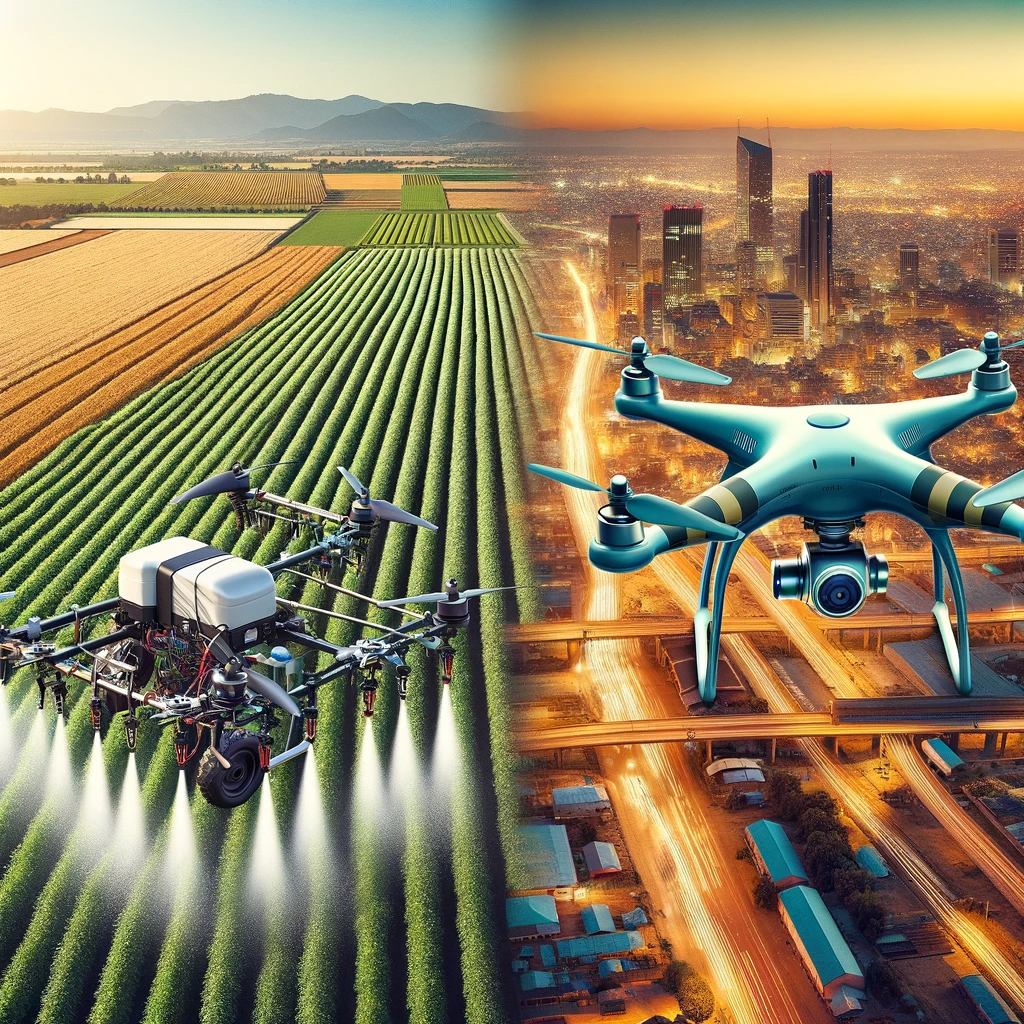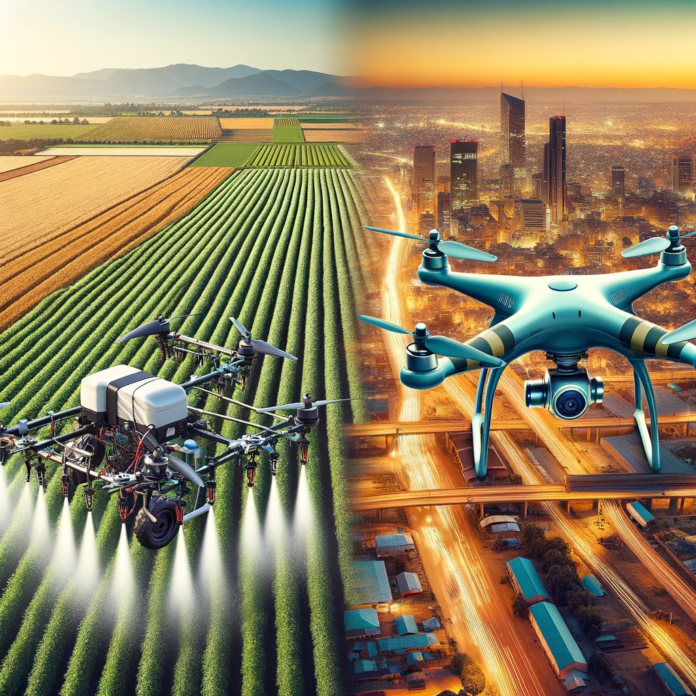
In today’s rapidly advancing world of technology, the use of drones has become increasingly common and diverse. Among the various types of drones, agricultural drones stand out for their distinctive characteristics and unique functions. Unlike other types of drones that are primarily used for recreational purposes or aerial photography, agricultural drones are specifically designed to revolutionize the way we farm and cultivate crops. With their advanced sensors and imaging capabilities, these drones help farmers maximize efficiency, monitor crop health, and make informed decisions regarding irrigation, fertilization, and pest control. In this article, we will explore the key features and benefits of agricultural drones, shedding light on how they differ from their counterparts in the realm of unmanned aerial vehicles.
Agricultural Drones vs. Other Types
When it comes to drones, there are several types available in the market, each with its own unique features and applications. Agricultural drones, also known as ag drones, are specifically designed and developed for use in the agricultural industry. These drones are distinct from other types in terms of technology, design and construction, purpose and functionality, flight time and range, regulations and legal considerations, cost and affordability, training and expertise, challenges and limitations, and integration with other technologies.
Technology
Use of Advanced Imaging Systems
One key difference between agricultural drones and other types is the use of advanced imaging systems. Agricultural drones often come equipped with high-resolution cameras or multispectral sensors that can capture detailed images of crops or livestock. These imaging systems allow farmers to effectively monitor plant health, detect diseases or pests, and make informed decisions regarding crop management.
Integration of Sensors
Another technological feature that sets agricultural drones apart is the integration of various sensors. These sensors can measure environmental factors such as temperature, humidity, and soil moisture. By collecting and analyzing this data, farmers can gain valuable insights into the conditions affecting their crops, enabling them to optimize irrigation, nutrient application, and overall production efficiency.
Precision Navigation Systems
Agricultural drones also possess precision navigation systems, which enable them to fly with great accuracy. This ensures that the drones can cover every corner of a field and capture precise data or perform specific tasks. With the help of GPS and other satellite-based technologies, these drones can autonomously follow pre-programmed flight paths, reducing the chances of human error and enhancing efficiency.
Design and Construction
Size and Weight
Agricultural drones are typically larger and heavier compared to other types of drones. This is because they need to carry additional equipment such as sensors, imaging systems, and pesticide spraying mechanisms. The size and weight of agricultural drones allow them to withstand harsh conditions and fly with stability, even in strong winds, making them suitable for outdoor agricultural operations.
Payload Capacity
Another design aspect that distinguishes agricultural drones is their payload capacity. These drones are capable of carrying a significant payload, which can include nutrient or pesticide tanks, seed dispensers, or even thermal cameras for livestock monitoring. The ability to deliver payloads accurately and efficiently allows farmers to apply inputs precisely, ensuring optimal crop health and productivity.
Durability
Given the demanding nature of agricultural operations, durability is a crucial factor in the design of agricultural drones. These drones are built to withstand rough handling, exposure to dust, dirt, and moisture, and even occasional collisions. The robust construction and protective features of agricultural drones ensure their longevity and effectiveness in the challenging agricultural environment.
Purpose and Functionality
Crop Monitoring and Analysis
Agricultural drones excel in crop monitoring and analysis, providing farmers with valuable data on plant health and growth. By capturing high-resolution images and utilizing sensors, these drones can identify crop stress, nutrient deficiencies, diseases, and pests at an early stage. This allows farmers to take prompt action and apply targeted interventions, ultimately improving yields and reducing crop losses.
Precision Application of Inputs
One of the key purposes of agricultural drones is the precise application of inputs such as fertilizers, herbicides, or pesticides. Equipped with spraying mechanisms, these drones can accurately distribute these inputs based on specific crop requirements. By reducing waste and ensuring targeted application, agricultural drones contribute to sustainable farming practices and environmental conservation.
Livestock Management
In addition to crop-focused applications, agricultural drones can also aid in livestock management. Drones equipped with thermal cameras can monitor the health and behavior of animals, detect heat cycles, and identify injured or stranded livestock. This helps farmers detect and address potential issues, ensuring the well-being of their animals and improving overall herd management.
Environmental Monitoring
Agricultural drones can be used for environmental monitoring as well. By capturing aerial images and data, these drones can assess the condition of water bodies, detect soil erosion, and monitor the reclamation of land. This information is crucial for sustainable land management practices and enables farmers to make informed decisions that minimize the environmental impact of their agricultural activities.
Flight Time and Range
Battery Life and Capacity
One of the significant limitations of drones, including agricultural drones, is their limited flight time. Most commercial agricultural drones have a flight time of around 20-30 minutes per battery charge. However, advancements in battery technology are continuously improving flight time, allowing agricultural drones to cover larger areas more efficiently.
Remote Control and Autonomous Operation
To overcome the limitation of flight time, agricultural drones can be operated remotely or autonomously. Remote control allows farmers to manually pilot the drone and perform specific tasks. Autonomous operation, on the other hand, enables the drone to follow pre-programmed flight paths and carry out tasks automatically. This flexibility in control options ensures that farmers can utilize agricultural drones to their maximum potential.
Regulations and Legal Considerations
FAA Certification and Compliance
Operating drones, including agricultural drones, is subject to regulations set forth by aviation authorities such as the Federal Aviation Administration (FAA) in the United States. These regulations typically require operators to obtain certification, adhere to specific flight restrictions, and maintain a safe operating distance from people, buildings, and other aircraft. Compliance with regulatory requirements is essential to ensure the safe and responsible use of agricultural drones.
Restrictions and Privacy Concerns
Apart from aviation regulations, there may be additional restrictions on the use of agricultural drones due to privacy concerns. These concerns arise from the potential intrusion on private property or the unauthorized capture of personal data. It is crucial for agricultural drone operators to respect privacy rights and comply with any local or regional laws governing data collection and privacy.
Cost and Affordability
Initial Investment
The cost of agricultural drones, like any other technological equipment, can vary significantly depending on the make, model, and features. Generally, agricultural drones with advanced imaging systems, sensors, and spraying mechanisms tend to be more expensive compared to recreational or hobbyist drones. However, the initial investment in agricultural drones can be justified by the potential increase in crop yields, cost savings on inputs, and overall operational efficiency.
Operational Expenses
In addition to the initial investment, there are operational expenses associated with the use of agricultural drones. These expenses include battery replacements, maintenance and repair costs, insurance, and any necessary software or data management subscriptions. It is important for farmers to consider these ongoing expenses when evaluating the affordability and long-term viability of incorporating agricultural drones into their operations.
Training and Expertise
Skill Requirements
To effectively operate agricultural drones, operators need to possess certain skills and knowledge. These include piloting skills, understanding of drone regulations, proficiency in data analysis and interpretation, and the ability to troubleshoot technical issues. Familiarity with agricultural practices and knowledge of crop or livestock management principles are also beneficial for maximizing the benefits of agricultural drones.
Certification Programs
Various certification programs and training courses are available to help individuals acquire the necessary skills and knowledge for operating agricultural drones. These programs cover topics such as flight safety, navigation, data analysis, and maintenance. Completing these certification programs can provide operators with the credibility and confidence to operate agricultural drones proficiently and responsibly.
Maintenance and Support
Like any technology, agricultural drones require regular maintenance and occasional repairs. This can include battery maintenance, propeller replacements, and software updates. It is important for operators to have access to reliable technical support or have the knowledge and resources to carry out maintenance tasks themselves. Timely maintenance ensures the longevity and optimal performance of agricultural drones.
Challenges and Limitations
Weather Conditions and Environmental Factors
Agricultural drone operations can be affected by adverse weather conditions such as rain, wind, or extreme temperatures. Rain can damage the drone’s electronics, wind can cause instability or even lead to crashes, and extreme temperatures can affect battery performance. It is crucial for operators to carefully consider weather forecasts and ensure that drones are operated within safe limits to mitigate potential risks.
Interference and Communication Issues
Another challenge that agricultural drone operators may encounter is signal interference and communication issues. Drones rely on a stable connection between the remote control or ground station and the drone itself. Interference from other electronic devices or physical obstacles can disrupt this connection and affect the drone’s performance or even result in a loss of control. Operators must be aware of potential interference sources and take necessary precautions to minimize the risks.
Data Management and Cybersecurity
The collection and analysis of data by agricultural drones present challenges related to data management and cybersecurity. The vast amount of data generated by drones needs to be effectively stored, organized, and analyzed to derive meaningful insights. Data security and privacy measures need to be strictly followed to protect sensitive information from unauthorized access or cyber threats. Implementing robust data management and cybersecurity practices is vital for ensuring the integrity and confidentiality of agricultural data.
Integration with Other Technologies
Artificial Intelligence and Machine Learning
Agricultural drones have the potential to integrate with artificial intelligence (AI) and machine learning technologies, further enhancing their capabilities. AI algorithms can analyze drone-captured images and sensor data to automatically identify and classify crop diseases or pests, allowing for proactive intervention. Machine learning can also enable drones to learn from historical data and optimize flight paths for maximum efficiency. The integration of AI and machine learning with agricultural drones opens up possibilities for increased automation and precision in farming practices.
Internet of Things (IoT) Integration
Agricultural drones can be integrated with the Internet of Things (IoT) to create a connected and automated ecosystem. By incorporating IoT sensors and devices in the agricultural field, drones can wirelessly communicate with other devices and systems, enabling real-time monitoring and control. For example, drones can receive data from soil moisture sensors, process it, and autonomously adjust irrigation systems accordingly. This seamless integration of drones with IoT technologies improves overall operational efficiency and reduces manual intervention.
Blockchain Technology
Blockchain technology offers the potential for secure and transparent data management in the agricultural industry. By utilizing blockchain, agricultural drones can securely store and share data with other stakeholders, such as farmers, suppliers, and insurers. Blockchain ensures data integrity, traceability, and immutability, creating trust and facilitating seamless collaboration within the agricultural ecosystem. The integration of agricultural drones with blockchain technology can revolutionize data sharing, supply chain management, and traceability in agriculture.
In conclusion, agricultural drones differ from other types of drones in terms of their technology, design and construction, purpose and functionality, flight time and range, regulations and legal considerations, cost and affordability, training and expertise, challenges and limitations, and integration with other technologies. These unique features and capabilities make agricultural drones invaluable tools for modern-day farming operations, offering farmers the means to monitor and manage crops, optimize input application, enhance livestock management, and contribute to sustainable and efficient agricultural practices.

